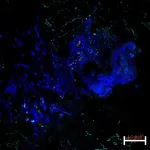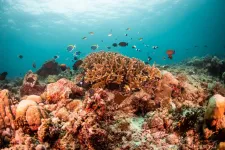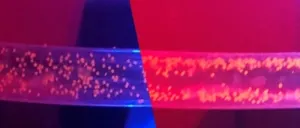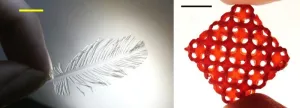NIH researchers discover new autoinflammatory disease, suggest target for potential treatments
2023-03-28
(Press-News.org) WHAT:
Scientists have identified an autoinflammatory disease caused by mutations in the LYN gene, an important regulator of immune responses in health and disease. Named Lyn kinase-associated vasculopathy and liver fibrosis (LAVLI), the identification sheds light on how genes linked to certain illnesses can potentially be targets for treatment by repurposing existing drugs. The research, published in Nature Communications, was led by Adriana A. de Jesus, M.D. Ph.D., and Raphaela Goldbach-Mansky, M.D., M.H.S. of the Translational Autoinflammatory Diseases Section of the Laboratory of Clinical Immunology and Microbiology at the National Institute of Allergy and Infectious Diseases (NIAID), part of the National Institutes of Health.
LAVLI was first discovered in a pediatric patient through genetic testing, which detected a mutation in LYN, the gene that encodes the Lyn kinase protein. Two additional, unrelated pediatric patients were later discovered to have two more mutations in the same gene. All three patients developed diseases linked to the LYN genetic mutation shortly after birth. Two patients developed liver fibrosis—excessive amounts of scar tissue caused by inflammation and repeated liver damage—in the first year of life. All three patients had perinatal onset of neutrophilic cutaneous small vessel vasculitis. This is an immune disorder characterized by inflammation from high numbers of neutrophils—white blood cells of the immune system—that can damage small blood vessels. The study revealed Lyn kinase was always active and unable to shut down in the three patients with the LYN mutation, which increased neutrophil migration, altered inflammatory signals and activated scar and fibrosis-inducing liver cells. The results of this study suggest that Lyn kinase may be a potential therapeutic target for drugs that treat forms of non-syndromic small vessel vasculitis and other types of inflammation-induced liver fibrosis.
ARTICLE:
AA de Jesus et al. Constitutively active Lyn kinase causes a cutaneous small vessel vasculitis and liver fibrosis syndrome. Nature Communications DOI: 10.1038/s41467-023-36941-y (2023).
WHO:
Dr. Raphaela Goldbach-Mansky, Chief of the Translational Autoinflammatory Diseases Section in NIAID’s Laboratory of Clinical Immunology and Microbiology, is available to discuss this research.
CONTACT:
To schedule interviews, please contact Jamie Rogers, (301) 402-1663, NIAIDnews@niaid.nih.gov.
NIAID conducts and supports research—at NIH, throughout the United States, and worldwide—to study the causes of infectious and immune-mediated diseases, and to develop better means of preventing, diagnosing and treating these illnesses. News releases, fact sheets and other NIAID-related materials are available on the NIAID website.
About the National Institutes of Health (NIH): NIH, the nation's medical research agency, includes 27 Institutes and Centers and is a component of the U.S. Department of Health and Human Services. NIH is the primary federal agency conducting and supporting basic, clinical, and translational medical research, and is investigating the causes, treatments, and cures for both common and rare diseases. For more information about NIH and its programs, visit https://www.nih.gov/.
NIH...Turning Discovery Into Health®
END
[Attachments] See images for this press release:

ELSE PRESS RELEASES FROM THIS DATE:
2023-03-28
The Korea Institute of Civil Engineering and Building Technology (KICT, President Kim Byung-suk) developed a smart sensor that detects signs of ground or structure collapses and a real-time remote monitoring system.
The development of the sensor and system began with a search for a method of instant sensing of the collapse of slopes or buildings caused by ground movement for immediate response. This led to the development of a smart sensor that turns on a LED warning light upon detecting ground movement. The ...
2023-03-28
Replacement per- and polyfluoroalkyl substances (PFAS) heralded as safe for use in food packaging break down into toxic PFAS that leak into our food and environment, suggests a study published today in Environmental Science & Technology Letters.
Due to the known exposure risks of using smaller PFAS molecules like PFOA and PFOS in food-contact materials, many companies have pivoted to using larger polymeric PFAS to make their wrappers, bowls, and other fast-food packaging water- and grease-repellant. ...
2023-03-28
Gaithersburg, MD—March 28, 2023 – Cartesian Therapeutics, a fully integrated biopharmaceutical company pioneering RNA cell therapy for autoimmune diseases and cancer, today announced the appointment of five internationally recognized experts in autoimmune diseases. Cartesian’s appointments include distinguished physicians and scientists as leaders in clinical trials and medicine.
“Cartesian is proud to have these prestigious, multidisciplinary advisors committed to treating other autoimmune diseases,” said Miloš Miljković, M.D., Chief Medical Officer at Cartesian Therapeutics. “Their perspectives will provide the utmost value ...
2023-03-28
Researchers at the University of Toronto, Indiana University and University of Notre Dame have detected levels of toxic PFAS chemicals—short for per- and polyfluoroalkyl substances—for the first time in Canadian fast-food packaging, specifically water-and-grease repellent paper alternatives to plastic.
Published today in Environmental Science and Technology Letters, the findings suggest that food packaging exposes people directly to PFAS, which have been linked to serious health effects such as increased cancer risk and immune system damage, by contaminating the food they eat. Further, once discarded packaging enters waste streams, PFAS enter the environment, where these ...
2023-03-28
HOUSTON – (March 28, 2023) – The road to a net-zero future must be paved with greener concrete, and Rice University scientists know how to make it.
The production of cement, an ingredient in concrete, accounts for roughly 8% of the world’s annual carbon dioxide emissions, making it a significant target of greenhouse gas emissions reduction goals. Toward those efforts, the Rice lab of chemist James Tour used flash Joule heating to remove toxic heavy metals from fly ash, a powdery ...
2023-03-28
CHAMPAIGN, Ill. — As new environmental regulations are rolling out to mitigate the industry-retired long-chain chemicals known as PFAS in drinking water, there are concerns regarding a new breed of “forever chemicals” called short-chain PFAS. Research from the University of Illinois Urbana-Champaign is helping shift the focus to include mitigation of the chemicals – which researchers say are just as persistent as, more mobile and harder to remove from the environment than their long-chain counterparts.
A ...
2023-03-28
SAN FRANCISCO, CA (March 28, 2023) — In a paper published today in the journal Environmental Research Letters, an international research team composed of scientists affiliated with more than a dozen institutions, including the California Academy of Sciences, propose a first-of-its-kind framework for governments around the world to evaluate their preparedness for—and guide future policies to address—ocean acidification, among the most dire threats to marine ecosystems.
“Ocean acidification is one of climate change’s silent killers,” says Rebecca Albright, PhD, Academy Curator of Invertebrate Zoology and ...
2023-03-28
In North America’s hottest, driest desert, climate change is causing the decline of plants once thought nearly immortal and replacing them with shorter shrubs that can take advantage of sporadic rainfall and warmer temperatures.
Many studies have documented how a hotter, drier world is causing a redistribution of plants in temperate mountain regions. A new UC Riverside study documents the unexpected ways plants in part of the Sonoran Desert are doing the same.
“The plants ...
2023-03-28
INDIANAPOLIS, March 28, 2023 — Colorful particles of plastic drift along under the surface of most waterways, from headwater streams to the Arctic Ocean. These barely visible microplastics — less than 5 mm wide — are potentially harmful to aquatic animals and plants, as well as humans. So, researchers are devising ways to remove them and to stop them at their source. Today, a team reports a two-stage device made with steel tubes and pulsing sound waves that removes most of the plastic particles from real water samples.
The researchers will present ...
2023-03-28
INDIANAPOLIS, March 28, 2023 — The ancient art of origami is well known for transforming sheets of paper and other foldable materials into complex 3D shapes. But now, chemical engineers have extended the centuries-old practice to produce intricate shapes made of glass or other hard materials. Their thoroughly modern method, which can be combined with 3D printing, could have applications ranging from sculpture to catalysis and beyond.
The researchers will present their results today at the spring meeting of the American Chemical Society (ACS). ACS Spring 2023 is a hybrid meeting being held virtually and in-person ...
LAST 30 PRESS RELEASES:
[Press-News.org] NIH researchers discover new autoinflammatory disease, suggest target for potential treatments








